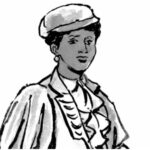A Promising Young Man Cut Down for Using a “Whites-Only” Bathroom
On January 3rd, 1966, Samuel (Sammy) Younge Jr., a 21-year-old Tuskegee Institute student and civil rights activist, was shot and killed by a white gas station attendant in Macon County, Alabama for trying to use the “whites-only” restroom.
Younge’s senseless murder sent shockwaves through the civil rights movement, drawing comparisons to the violence suffered by Vietnamese peasants at the hands of the U.S. military.
Younge was a peaceful activist who had participated in the Selma to Montgomery marches just months earlier. But his death marked a turning point for many young civil rights organizers, who saw it as proof that nonviolence was not enough when facing the violence of white supremacy.
A Veteran Who Fought Abroad Only to Face Racism at Home
Younge was a native of Tuskegee who came from a comfortable, middle-class family. After graduating high school in 1962, he enlisted in the U.S. Navy and was assigned to a ship that participated in the Cuban Missile Crisis.
But Younge’s military career was cut short in 1964 when one of his kidneys failed, leading to a medical discharge. Ironically, Younge had risked his life serving his country abroad, only to return home to face the deadly realities of racism in America.
Back in Alabama, Younge immersed himself in the civil rights movement, joining groups like the Student Nonviolent Coordinating Committee (SNCC) and working to register Black voters across the South. This activism often put him directly in the line of racist violence and intimidation.
The Spark That Lit a Fire in the Movement
On January 3rd, 1966, Younge walked into a gas station in Tuskegee and attempted to use the restroom marked “Whites Only.” The attendant, 67-year-old Marvin Segrest, told Younge he had to use the “Colored” restroom instead.
When Younge rightly protested that segregation was illegal under the Civil Rights Act, Segrest shot him dead on the spot.
Segrest claimed Younge had threatened him with a golf club, but the blatant nature of the crime prompted SNCC to issue a scathing statement just three days later. They compared Younge’s murder to the killings of Vietnamese civilians and accused the U.S. government of hypocrisy for claiming to fight for freedom abroad while crushing liberation movements at home.
A Martyr Whose Death Changed Everything
Marvin Segrest was later acquitted of Younge’s murder by an all-white jury after just 70 minutes of deliberation. The miscarriage of justice led to protests in which demonstrators threw paint on a Confederate statue in Tuskegee and cried out for “Black Power.”
Many civil rights activists date the demise of nonviolence as a tactic to Younge’s death in 1966. As SNCC’s executive secretary later wrote, it was “one death too many” and marked “the end of tactical non-violence” for frustrated young Black organizers.
While Younge’s name may not be prominent in history books today, his needless murder fundamentally changed the civil rights movement. It sparked a racial reckoning in Tuskegee that led to Black politicians gaining power where there had been almost none.
So while Sammy Younge Jr.’s promising young life was cut short, his martyrdom shifted the tide against injustice in the town where he drew his last breath. Few deaths have impacted the fight for equality so profoundly.





